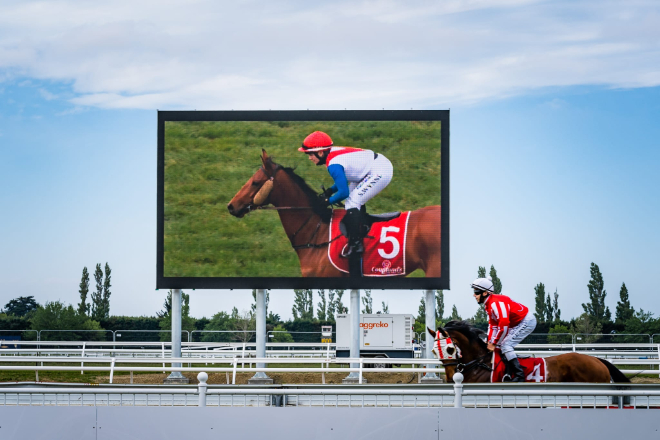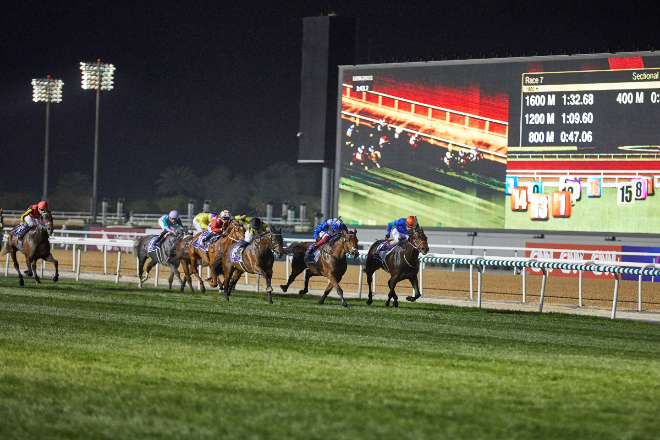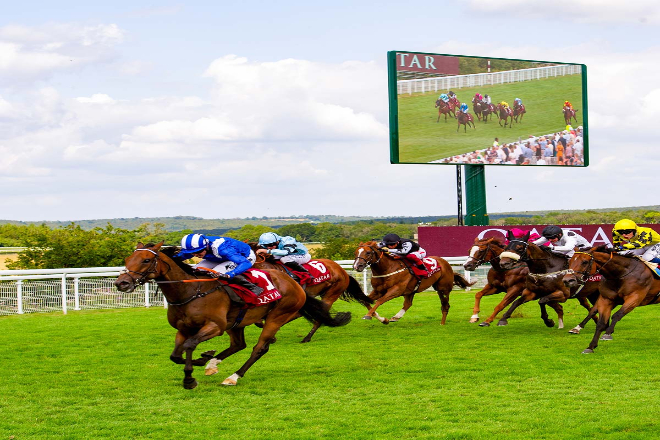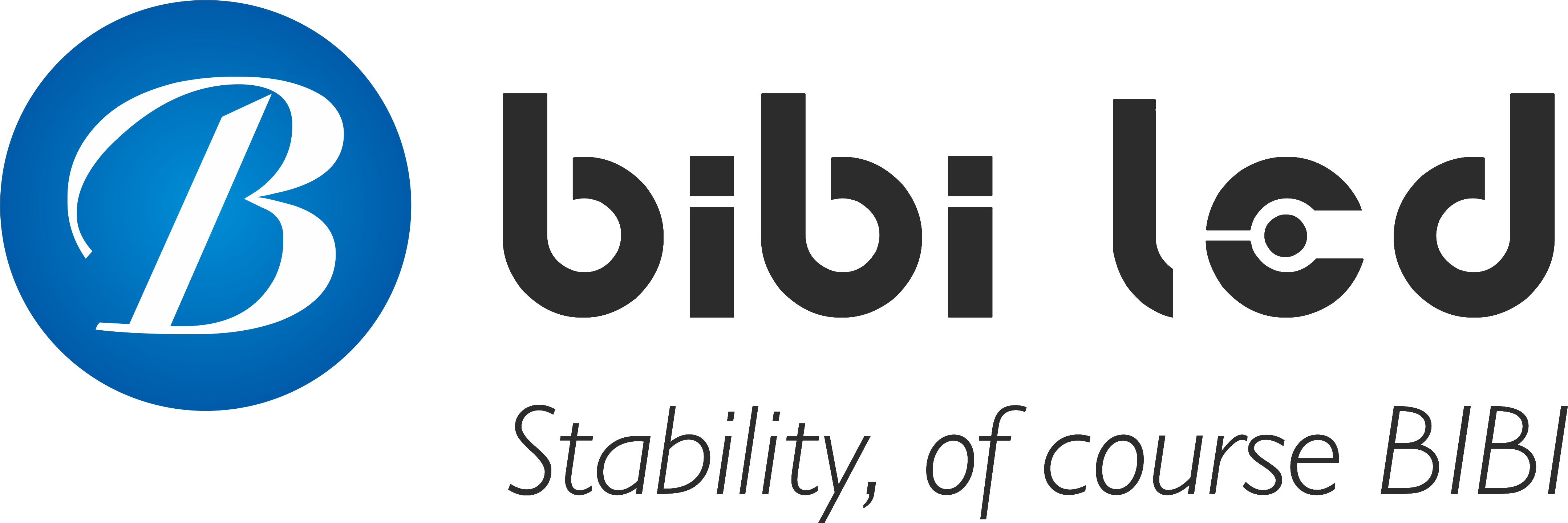Introduction
Have you ever thought that those LED displays shining on the racecourse are not just tools for displaying images?
There are many magical functions hidden behind them, from improving the viewing experience to ensuring the safety of the race and even spreading the culture of horse racing.
Today, let us step into the world of LED displays and see how they add more charm to horse racing!
Table of Contents
Method 1: Visual presentation and atmosphere creation for horse racing

1). Panoramic display of the track
Imagine that you are sitting in the stands of the racecourse, far away from the track, and your sight is blocked by the crowd, making it difficult to see the details of the horse racing. At this time, large LED displays come in handy.
For example, the Hong Kong Shatin Racecourse’s LED screen is like a huge “eye”, capturing every detail on the track and transmitting it to the screen in real time.
No matter where the audience sits, they can clearly see the starting moment of the horse race, the mud splashed by the galloping horseshoes, and the tense duel in the final sprint.
This panoramic display makes the audience feel as if they are in the center of the track, greatly enhancing the immersive feeling of watching.
Another example is that some racecourses in the United States have installed large 4K LED screens, and the images are so clear that even the horse’s mane can be seen clearly.
This high-definition picture display allows the audience to feel the heroic spirit of the racehorse even from a distance.
2). Display of horse and jockey information
Before the race starts, the LED screen will scroll the “resume” of each racehorse, such as pedigree, record, and jockey information.
Just like watching a wonderful movie trailer, the audience can quickly find the racehorse and jockey they are interested in through this information.
For example, if a racehorse has won the championship or a jockey is a well-known “gold medal jockey”, this information will be displayed with dynamic text and pictures so that the audience can see it at a glance.
Moreover, this information will be updated in real time according to the progress of the race.
For example, when a racehorse performs well in the race, its detailed information will pop up on the screen immediately, and the audience can immediately understand the “greatness” of the horse, so as to watch the race more attentively.
3). Atmosphere creation and interaction
At the critical moment of the horse race, the role of the LED screen is more obvious. For example, when the horse race is about to start, the screen will turn red and play tense drum beats to speed up the audience’s heartbeat.
When the horse races sprint, the screen will flash, simulating the running rhythm of the horse race, making the audience feel as if they are running themselves.
Moreover, the LED screen can also guide the audience in interacting. For example, before the start of the game, a countdown will appear on the screen, and the audience will shout “3, 2, 1” along with the countdown, creating a tense atmosphere.
After the game, a “cheer prompt” will pop up on the screen to encourage the audience to cheer for the winning horse and jockey, bringing the atmosphere to a climax.
For another example, some racecourses will set up interactive games on the LED screen, such as guessing which horse will win.
The audience can participate by scanning the code on their mobile phones, and the audience who guesses correctly can also get small gifts.
This interactive method makes the audience no longer a mere spectator but a part of the game, which greatly enhances their sense of participation and fun.
In short, through these vivid visual presentations and interactive designs, the atmosphere at the horse racing scene has become more enthusiastic and the audience’s experience has become richer.
Method 2: Support for real-time data and analysis of horse racing
1). Real-time speed and position tracking
When you watch a race at a racecourse, your eyes are fixed on the horses on the track, but sometimes your sight is blocked by the crowd, or you simply don’t have time to react to the speed and position of the horse.
At this time, the LED display is like a “super eye”, which transmits the speed, ranking and position changes of the horse to the screen in real time through sensors installed on the track.
For example, the staff of the racecourse will install some small sensors on the horse’s back. These sensors are like “little messengers” that transmit the real-time data of the horse back to the control center and then display it through the LED screen.
The audience can see the speed of each horse, who is in front and who is behind, at a glance. This real-time data display is very helpful for horse racing training and game strategy formulation.
For example, the trainer can adjust the training plan according to the real-time speed of the horse in the race to make the horse more explosive in the sprint stage.
The jockey can also adjust the tactics according to the real-time position, such as when to accelerate and when to maintain physical strength.
2). Data analysis and prediction
LED display screens not only simply display data but also help spectators and professionals predict the results of the game by analyzing historical data.
For example, some racecourses collect data such as the speed and sprinting ability of horses in the past few games, and then display them in the form of charts.
The audience can see the physical curve of the horse in the game, such as whether it maintains a constant speed in the first half of the game or is more explosive in the second half.
What’s more, some platforms will use big data and machine learning algorithms to predict the results of the game.
It’s like having an “intelligent brain” that analyzes factors such as the horse’s historical performance, weather conditions, and track conditions and then gives a prediction.
For example, the Horse888 platform collects various data and then uses a unique algorithm to predict which horse may win.
This data analysis and prediction function not only makes it easier for spectators to understand but also gives professionals more basis for decision-making.
3). Event management and decision support
LED display screens are like a “super assistant” for event organizers. During the game, if there is an emergency, such as a horse injury or an obstacle on the track, the organizer can quickly obtain information through the LED screen.
For example, the sensor will send back the location and condition of the horse’s injury in real-time, and the organizer can immediately arrange for rescue personnel to deal with it.
In order to ensure the security and accuracy of the data, the racecourse will use some high-tech means.
For example, encryption technology will be used for data transmission, just like putting on “protective clothing” to prevent hacker attacks or tampering. At the same time, the data will be backed up and stored in case of loss and can be restored at any time.
In this way, the organizers of the event can safely rely on this data to make decisions, such as adjusting the track conditions or handling emergencies to ensure the smooth progress of the race.
In short, through these technical means, the real-time data and analysis support of horse racing not only make the audience more enjoyable, but also make the event management and decision-making more scientific and efficient.
Method 3: Improve the commercial value of horse racing

1). Advertising and brand promotion
The advertising value of LED display screens at horse racing sites is very high. It can not only attract the attention of a large number of spectators, but also attract sponsors and advertisers through precise positioning and high-frequency exposure.
For example, at the horse racing site, the LED screen can display the brand information of the event sponsor, including brand logos, slogans and product pictures.
Through dynamic display and high-definition images, brand information can be conveyed to the audience more intuitively, thereby increasing brand awareness.
For example, in Hong Kong horse racing events, LED screens will display the brand logos and event-related information of sponsors. While watching the race, the audience will also be impressed by the sponsor’s brand.
This high-frequency exposure can effectively increase brand exposure and audience awareness.
In addition, LED screens can also attract audience participation through interactive functions, such as setting up lucky draws or interactive games, and audiences can participate by scanning QR codes.
Not only can it increase the audience’s sense of participation, but it can also bring more exposure opportunities for the brand.
2). Audience flow and market expansion
LED display screens can increase the audience flow and market influence of horse racing by attracting audiences and improving the viewing experience.
For example, by displaying exciting race moments, real-time data, and horse racing information, LED screens allow audiences to have a richer viewing experience, thereby attracting more audiences to watch the race.
At the same time, the interactive function of LED screens can also attract young audiences and new audience groups.
For example, some racecourses will set up interactive sessions on LED screens, where spectators can interact with the races through mobile voting, participating in guessing games, etc. This novel experience can attract young spectators and new audience groups.
Take Australia’s “Peak Race” as an example. This event successfully attracted a large number of young spectators by displaying event information and interactive content on LED screens, of which 80% of the participants were under 35 years old.
This way of attracting spectators by improving the viewing experience and interactivity not only increases spectator traffic, but also expands the market influence of horse racing.
3). Live broadcast of events and global communication
LED display plays an important role in the high-definition live broadcast of horse racing.
It can support high-definition and real-time event broadcasts, allowing spectators to feel the immersive effect whether they are watching the race on site or on TV or the Internet.
For example, Hong Kong’s horse racing events have attracted a large number of international spectators through LED screens and high-definition broadcasting technology.
In addition, the multi-language support and interactive functions of LED screens can also attract international audiences.
For example, in international events, LED screens can switch between multiple languages, display event information and interactive content, allowing audiences from different countries to easily participate.
This global communication method not only enhances the international influence of the event, but also brings more business opportunities to the event.
Through these methods, LED display screens not only enhance the commercial value of horse racing, but also provide strong support for the global communication and market expansion of the event.
Method 4: Safety and regulatory guarantee for horse racing
1). Health monitoring of racehorses and jockeys
The safety of racehorses and jockeys is the top priority of the competition.
Now, racecourses use high-tech health monitoring equipment, such as putting a “smart collar” on horses, which can monitor key data such as body temperature, heart rate, blood oxygen content and blood pressure in real-time.
These data will be transmitted to the monitoring center via wireless signals and then displayed on the LED screen in real-time. Staff sitting in the monitoring room can see the health status of the horses at any time.
If they find that the horse’s body temperature suddenly rises or the heart rate is abnormal, they can take measures immediately to prevent the horse from being injured.
This monitoring system has been used in some large-scale events, and its effect has been particularly good.
For example, in Hong Kong horse racing events, with this high-tech equipment, staff can detect health problems of horses in time, and the number of horse injuries during the race has been significantly reduced.
2). Track safety and environmental monitoring
The safety of the track is also critical. The LED display can not only display the health data of the horses and jockeys but also display the track’s real-time environmental data, such as weather, temperature, humidity, etc.
For example, if it suddenly rains heavily, the LED screen will immediately display weather warning information to remind spectators and staff to pay attention to safety.
At the same time, by monitoring the humidity and temperature of the track through sensors, staff can adjust the maintenance measures of the track based on these data.
For example, if the track is too slippery, they can clean up the accumulated water in time to ensure that the track conditions are suitable for the race.
The early warning function of the LED screen is also very powerful. If there are obstacles or other safety hazards on the track, the screen will immediately sound an alarm to remind jockeys and staff to deal with them quickly.
This real-time monitoring and early warning mechanism greatly improves the safety of the track.
3). Event supervision and fairness guarantee
The fairness of horse racing is also very important. The LED display provides great help for event supervision through real-time data recording and playback functions.
During the competition, the high-definition video recording function can capture every detail, such as the horse’s sprinting moment and the jockey’s movements.
These records can not only be used for subsequent analysis of the event but also provide solid evidence when disputes or violations occur.
For example, in international equestrian competitions, jockeys may sometimes use spurs or whips illegally. Through high-definition video playback, referees can more accurately judge whether the jockey’s actions are illegal, thereby ensuring the fairness of the competition.
In addition, the LED screen can also display the results and rankings of the competition in real time, so that the audience and participants can clearly understand the progress of the competition, further enhancing the transparency and credibility of the event.
In short, through these high-tech means, the safety and supervision of horse racing competitions have been effectively guaranteed.
Not only is the health of horses and jockeys protected, but the fairness of the competition and the audience’s viewing experience has also improved.
Method 5: Cultural communication and educational function of horse racing

1). Horse racing culture display
In foreign countries, horse racing culture has a profound history and unique traditional customs, and LED display screens can be an excellent platform to display these cultures.
For example, the Kentucky Derby in the United States is one of the most prestigious events in the American horse racing industry.
It has been held in Louisville, Kentucky on the first Saturday of May every year since 1875.
During the horse racing festival, the audience will dress up and the ladies will wear gorgeous hats. This tradition originated from the British horse racing etiquette.
Through the LED screen, the historical origins and traditional etiquette of the Kentucky Derby can be displayed, as well as various celebrations during the horse racing festival, such as horse racing, parades, and craft exhibitions.
Another example is the Melbourne Cup Horse Racing Festival in Australia, which is an international event held at the Flemington Racecourse in Melbourne on the first Tuesday of November every year.
It is called “the event that makes a country stop”, and people all over Australia will stop what they are doing on that day and pay attention to this game.
By displaying the history of the Melbourne Cup, the style of the racecourse, and the highlights of the event on the LED screen, the audience can better understand the cultural background of the event.
2). Popularization of horse racing knowledge
During the intervals between races, LED screens can be used to popularize horse-racing knowledge. For example, display content such as horse racing training, feeding, and competition rules.
Taking American horse racing as an example, the Kentucky Derby is the first stop of the American horse racing “Grand Slam”, and participating horses must be 3 years old.
Through animation and text introduction, the training process of horses can be displayed.
For example, how to improve speed and endurance through scientific training methods. It can also display knowledge about horse breeding, such as horse diet, health monitoring, etc.
In addition, through interactive Q&A and educational videos, audiences can be attracted to learn horse-racing knowledge.
For example, an educational video about horse racing rules is played on the LED screen, and then an interactive Q&A session is set up.
The audience can participate in answering questions by scanning the code on their mobile phones, and the audience who answers correctly can get small prizes.
This method not only increases the audience’s sense of participation but also allows them to learn horse racing knowledge in entertainment.
3). Community and educational activities support
LED screens can also support community activities and educational projects related to horse racing.
For example, in youth horse racing experience activities, LED screens can display basic horse racing skills and safety knowledge to help children better participate in activities.
In horse racing culture lectures, LED screens can display the PPT content of the lectures, allowing the audience to see the content of the lectures more clearly.
Take the Royal Ascot Jockey Club in the UK as an example. This is a long-standing horse racing event, and the audience will attend in formal dresses.
Displaying the etiquette and dress requirements of the Jockey Club on LED screens can allow community residents and students to better understand the horse racing culture.
In addition, through the interactive function of LED screens, community residents and students can be attracted to participate in horse racing cultural activities.
For example, in community activities, a horse racing knowledge question and answer session is set up, and the audience can see the questions through the LED screen, and then vote on the answer through the mobile phone.
This method can increase the fun and participation of the event.
In short, through the multiple functions of LED screens, the cultural communication and educational functions of horse racing have been greatly improved.
This not only allows the audience to better understand the horse racing culture, but also lays the foundation for the inheritance and development of horse racing.
6. Conclusion
After reading this, do you think that LED displays play a more important role in horse racing than you thought?
They are not just screens, but also a bridge connecting the audience and the world of horse racing.
Finally, if you want to know more about LED displays, please get in touch with us.
